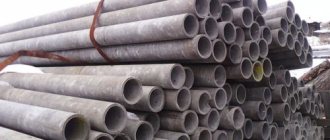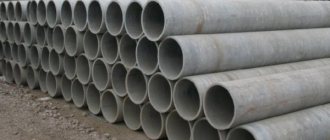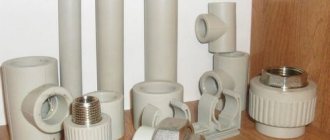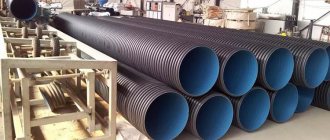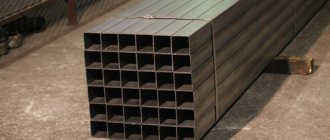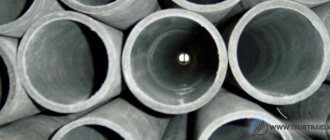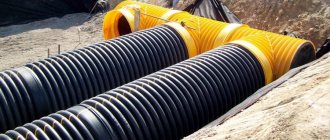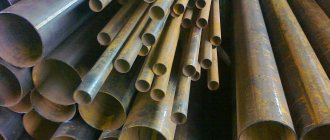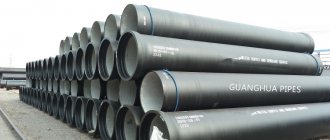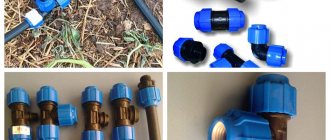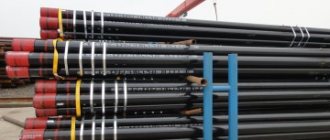STATE STANDARD OF THE USSR UNION
PUMP-COMPRESSOR PIPES AND COUPLINGS FOR THEM
TECHNICAL CONDITIONS
GOST 633-80
Moscow
STATE STANDARD OF THE USSR UNION
| PUMP-COMPRESSOR PIPES AND COUPLINGS FOR THEM Specifications | GOST 633-80 |
Date of introduction 01/01/83
regarding pipes of execution A 01.01.84
This standard applies to smooth steel seamless tubing pipes and couplings for them, with upset ends and couplings for them, smooth high-tightness and couplings for them, as well as coupling-free pipes with upset ends, used for the operation of oil and gas wells.
(Changed edition, Amendment No. 3).
Strength groups
Steel with strength groups K, E, L, M is required for the production of smooth samples, as well as coupling joints. Steel with strength groups D, K, E, L, M is required for the production of seamless steel with upset ends.
Standards for mechanical properties of steel
Even with a slight deviation from the standards, the entire batch is rejected and subject to remelting. If the product cannot be restored, it is written off.
Characteristics and grades of tubing steel
Operation in harsh climates requires manufacturers to use especially strong steels.
Important! The following steel grades are used for manufacturing: 30ХМА, 30, 20.
Structural carbon steels:
- " 30ХМА ". Relevant for the manufacture of parts operated at extremely high temperatures (up to +450 degrees). Contains up to 0.3% carbon. The letter “A” indicates the highest quality of steel. Gas lift samples for compressed air are made from it. Even used products made from this material retain their first-class qualities.
- «30»: Required for making couplings. Provides medium surface hardness.
- «20»: Required for the manufacture of couplings, bearings and other parts intended for use under pressure. Provides high surface hardness.
Basic requirements for tubing operation
Despite their strength, steel products require special treatment.
Storage requires compliance with the following rules:
- The incoming batch should be unloaded only onto a prepared area (preferably under a canopy). In this case, laying should be carried out on a beam laid along its entire length in a transverse plane.
Warehousing conditions
- Carrying products by drag is not allowed! This method can cause sagging. For this purpose, mechanized special equipment is used.
- Before starting installation work, remove all contaminants from the surface, but do not damage the protective lubricant.
- It is prohibited to use a sledgehammer when completing a well or when forming a pipeline. Shock loading will reduce the quality of the product. In particular, its integrity may be compromised. Erosion can develop from the slightest crack, as moisture and dust will accumulate in it. Therefore, it is better to use a landing nipple.
The technical condition of the product is checked by a template that is passed through it. The template should be 3 mm smaller in diameter than the actual diameter of the product. He should come out freely.
As a rule, the surface of products is painted during transportation to prevent corrosion. But at the customer’s request, the painting can be replaced by a layer of lubricant. It is also needed at the moment of screwing with the coupling.
These rules are relevant for all industries:
- oil and gas;
- construction;
- industrial.
Particularly high operational requirements are imposed when constructing wells.
Columns and tubing lift
When designing a column, the fact that it will need to be brought to the surface several times is taken into account. In addition, from time to time there is a need to carry out maintenance or restoration activities. For example, with the help of a UOC (a highly functional device for cleaning columns), a drill pipe with a funnel is freed from paraffin deposits.
The development is focused on quick installation and dismantling.
Important! Several columns can be installed in one well. However, practice shows that the best option is two columns.
Structurally, the well consists of several intervals:
- Several casing strings: guide, gear, intermediate, main - production, cover string, liner (an important part of it is the shoe).
- Drilling area.
- Cementing area.
- Mouth.
- Slaughter.
- Perforation area.
SBT (interpretation: steel drill pipe) is lowered into the borehole to transmit rotation or transport compressed air to the bottom.
Oil and gas well drilling process
Oil or gas begins to flow to the surface thanks to insert pumps. The reciprocating mechanism is brought into working position by the sucker rods. With the help of rods, uninterrupted movements from the plunger to the pumping machine begin. This ensures the descent and ascent of the pumping system.
There are a number of technological requirements that columns must satisfy. First of all, they must be resistant to mechanical loads and have local tensile strength. The level of strength is determined by the ability to withstand the loads encountered during acidizing or during hydraulic fracturing activities.
Throughout the entire period of use, the column must show resistance to corrosion. Compliance with all of the above conditions guarantees that the service life of the column will not be limited to twenty years.
Well design diagram
Pump and compressor products included in the column design are the best option for performing many professional tasks:
- perforating the productive cement layer;
- groundwater detection;
- performing acid work;
- hydrochloric acid treatment of deep layers;
- crushing rocky plugs;
- determination of downhole pressure.
For any use case, experts define the rise to the surface of the substance being developed as a “fountain” or “elevator method.”
Tips for choosing products
The choice should be based on the functional task. When placing an order for a specific type, it is necessary to note what type of well the product will be used on.
In this case, the manufacturer must provide:
- couplings;
- all technical documentation;
- description of the product (the volume and intended operating instructions must be indicated);
- user manual;
- a list of parameters of couplings to prevent discrepancies with the markings.
Drill pipes with internal polymer and external combined coating
The choice is determined by the nature of the pumped out medium. Perhaps the products will come into contact with oil, gas or bitumen? Each type of well requires the use of a specific variety.
Important! Decent quality of products can only be guaranteed by a trusted manufacturer with a license for professional activities.
You can only purchase certified products.
Tubing decoding or what is it?
The abbreviation “NKT” is well known to oil and gas industry specialists. This is a short designation for pump and compressor pipes (this is how it stands for). They serve as a basic element for organizing the operation of wells. This concept is also relevant for aviation, where special requirements are imposed on the production of equipment.
The operating conditions in which these products are used are close to extreme. They undergo enormous operational loads. The very principle of well operation is based on constant contact with a chemically aggressive environment.
Oil Country Drill Pipe
Accordingly, special requirements are imposed on the quality of these products:
- high degree of permeability (including in sections of wells with curvature);
- absolute tightness at the ends (at joints);
- quick release coupling (QR);
- resistance to mechanical load;
- resistance to abrasion and corrosion;
- preventing oxidation of the transported medium;
- wear resistance;
- immunity to changes in temperature;
- impeccable quality of workmanship.
Finally, the product must be flexible. This will ensure that the basic operating parameters (integrity, tightness, geometric proportions) are observed when the level of heating or pressure inside the system changes.
Protection of the inner surface of the walls
A reliable way to prevent corrosion of 89x6 or 73x5 pipes is to apply a protective coating.
First, degreasing, shot blasting and dust removal are carried out. The already prepared inner surface is treated with a primer layer. After this, according to the technological process, the entire batch is sent to drying chambers. The task of this stage is to activate the graver. The final step is the application of epoxy powder paint.
The final hardening of the protective layer occurs in the polymerization chamber. After this stage, the coating acquires an extremely smooth, almost glossy surface.
Important! This multi-stage technology guarantees the most effective protection against resin-paraffin deposits and minimizes the effects of salts.
The 89x6 pipe becomes three-layer:
- wall;
- primer;
- inner layer (protective).
In conventional samples, there is no middle layer: primer. This weakens performance.
The basic characteristic of a protective coating is elasticity. It becomes resistant to mechanical and chemical influences. Under the most extreme operating conditions, the elastic coating is not subject to deformation.
One of the most dangerous operational moments is the disconnection of the thread and the coupling (stripping).
Manual external thread cutting
Shear loads are potentially dangerous. It occurs when the threads are deformed. The protection prevents changes in geometric parameters at the point of threaded connection with the coupling.
Vitrification as a form of protection is also common.
The advantages of the protective coating are:
- High coefficient of resistance to torsion and bending.
- Resistance to the formation of cracks and fractures.
- Resistant to chipping and shock loads.
- Ecological cleanliness.
The advantages of using such samples are safe oil production. They reduce the percentage of emergency situations, and overall productivity increases. At the same time, the financing required for the oil industry is reduced by minimizing current operating costs.
Manufacturers
In 2021, the following manufacturers confidently declared themselves on the market:
| "Metal Complex", Moscow |
| Revda Hardware and Metallurgical Union LLC, Revda |
| "Metal-Complex", Moscow |
| "Metpromko", Ekaterinburg |
| LLC NPP "ZST" |
| LLC "TK NKT" |
| "ChTPZ", Moscow |
| LLC "PTMZ", Novoalekseevskoe |
| PERVOURAL PIPE-MECHANICAL PLANT (PTMZ), Pervouralsk |
| "Tyumen Oil and Gas Equipment Plant", Tyumen |
| OOO "NEFTETRUBSERVICE" |
In addition to “new” ones from the manufacturer (for example, NKV, NKT 76 or 140), secondary equipment is actively offered on the market. NKT bu is steamed in a special way, cleaned of deposits and degreased.
Important! In the total stock of well equipment NKT used ones occupy a significant part.
Connection rules (installation)
All NKT with threaded connections are screwed together without adapters with couplings of strictly appropriate size (according to GOST 633-80).
Table 3. Connection rules (installation)
Deviations from these standards are fraught with emergency situations due to leaky connections.
The tightness of couplingless products is guaranteed if the operating pressure does not exceed 50 mPa. They are connected very firmly due to the fact that the ends are equipped with an outward landing. To make the connection possible, manufacturers provide conical sealing surfaces as standard. They (seals) are located directly behind the threads.
Coupling models are also guaranteed tightness if the operating pressure does not exceed 50 mPa.
Tubing pipe marking
A mandatory condition for the production of nct is the application of markings. It is located at the end, next to the end (directly at the coupling attachment point).
According to GOST 10692, the company mark includes the following information:
- Month and year of manufacture.
- Outer wall thickness (mm).
- Nominal diameter (mm).
- Steel grade. Smooth samples with heat-strengthened ends must have the additional designation “TUK”.
- Manufacturer's trademark.
Marking is done in two ways: knurling or impact. This area of the product is emphasized with contrasting light-colored paint.
For diameters from 27 mm to 48 mm, not paint is used for marking, but the impact method. Sometimes manufacturers use knurling on a special metal tag, which is attached to each package (bundle). The tag also contains summary information about the length and total weight in the package.
In addition, markings must be on the couplings.
Marking of equipment with impact stamping
Information is applied to them by knurling or impact:
- manufacturer's trademark;
- coupling manufacturing option;
- strength group.
Important! During shipment of products, samples of one batch are placed in the wagon. The package is fastened at 2 points.
If for some reason it is necessary to ship products from different batches, then it is necessary to ensure their separation. At the same time, it is rational to lay the products so that the flared ends “look” in the same direction.
